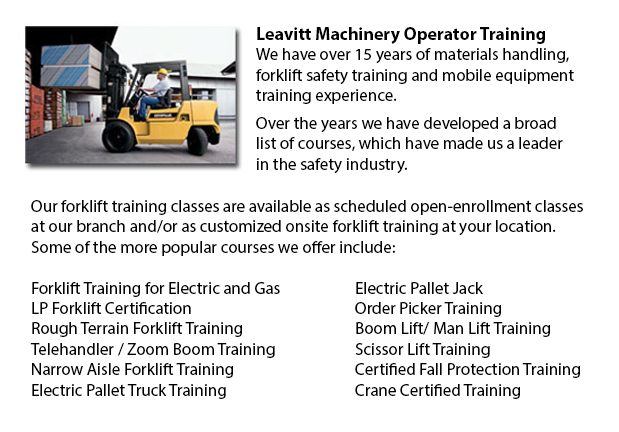
Langley Forklift Training Schools - Forklift Training Schools - The Best Option To Have A Safe And Efficient Work Area
Are you searching for a job as a forklift driver? Our regulatory-compliant mobile equipment operator training offers instruction in types of lift trucks, pre-shift inspection, fuel kinds and handling of fuels, and safe use of a lift truck. Practical, hands-on training helps participants in acquiring essential operational skills. Course content comprises current rules governing the use of lift trucks. Our proven forklift courses are intended to offer training on these types of trucks: powered pallet truck, narrow isle forklift and counterbalanced forklift.
Do not lower or raise the fork while the lift truck is traveling. A load should not extend over the backrest because of the danger of the load sliding back toward the operator. Check for overhead obstructions and ensure there is sufficient clearance prior to lifting a load. Stay away from overhead power lines. When the load is lifted straight up, tilt it back slightly.
When the load is raised the lift truck will be less steady. Make certain that no pedestrians cross under the elevated fork. The operator must not leave the forklift while the load is raised.
While handling pallets, forks must be level and high enough to go into the pallet and extend all the way below the load. The width of the forks must provide equal distribution of weight.
Chock the wheels and set the brakes prior to unloading and loading the truck. The floors should be strong enough to support the combined weight of the load and the forklift. Fixed jacks can be installed in order to support a semi-trailer that is not coupled to a tractor. The entrance door height should clear the height of the forklift by a minimum of 5 cm. Mark edges of rail cars, ramps or docks and avoid them.
-
Operator Safety Certification | Re-Qualification Certification | In-House Instructor Certification in Langley
Lift trucks are utilized in nearly all warehouse operations and in boat yards and in industrial construction sites. The reach feature of a forklift is a vital component used in several applications like for example whenever a shelving system is being... More -
Skid Steer Loader Certification in Langley
The engine powered skid-steer loader consists of a small and rigid frame, equipped along with lift arms that could connect to numerous industrial attachments and tools to carry out several labor saving jobs. Normally, skid-steer loaders are four-whee... More -
Langley Forklift Training Classes
Langley Forklift Training Classes - Forklift are heavy pieces of industrial machines that are utilized in transporting and the handling of merchandise and materials. They are often known as Lift trucks and are found in all kinds of industries. Employ... More -
Langley Heavy Equipment Operator Certification
Langley Heavy Equipment Operator Certification - The heavy equipment operator is an individual who manipulates the controls and drives various kinds of big machinery. Heavy machines is most commonly used on construction sites in order to deliver supp... More -
Langley Crane License
Langley Crane License - Crane operators ought to be "credentialed", which means they ought to own a crane operator license or certification. Credentialing is considered a mandatory governmental prerequisite to be able to practice as a crane operator.... More -
Langley Forklift Training School
Langley Forklift Training School - Forklift Training School And What It Truly Has To Provide - Industry and federal regulators have established the criteria for forklift safety training according to their current standards and regulations. People wis... More -
Langley Boom Lift Certification
Langley Boom Lift Certification - Elevated work platforms allow maintenance operations and work to be performed at heights that can not be reached by whichever other way. Workers utilizing boom lifts and scissor lifts could learn how to safely operat... More -
Langley Manlift Safety Training
Langley Manlift Safety Training - Manlift operators need to be cognizant and aware of all the potential dangers which are connected with specific classes of scissor lifts. They have to be able to operate the scissor lift in a way that protects not on... More

Forklift Certification Langley
TOLL FREE: 1-888-254-6157
Langley, British Columbia
forkliftcertificationlangley.com
Email Us
About Us


